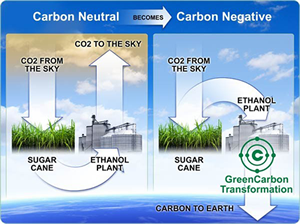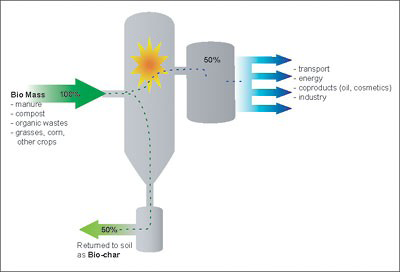
 |
 |
| Projects |
| Sustainability |
| Issues |
| Public Appearances |
| SOS Press |
| Reading Room |
| Links/Resources |
| What You Can Do |
| About SOS |
| People of SOS |
| Contact Us |
| Site Map |
| Home Page |
— Biochar —
What is Biochar?
Biochar is a soil amendment with the potential to revolutionize soil management,  biomass waste and carbon sequestration. Biochar has been used in traditional agricultural practices for millennia,1 as well as in modern horiticulture. Biochar's unique properties make it exceptional for sustainable soil management,2 effective conversion of biomass to energy and long term sequestration of carbon.
biomass waste and carbon sequestration. Biochar has been used in traditional agricultural practices for millennia,1 as well as in modern horiticulture. Biochar's unique properties make it exceptional for sustainable soil management,2 effective conversion of biomass to energy and long term sequestration of carbon.
What does it do?
Biochar has outstanding characteristics significant to climate change and soil fertility.
- Nutrient and Water Affinity: Organic matter added to soil significantly improves soil functions, including retaining nutrients essential to plant growth. Biochar has proven to be much more effective in attracting, retaining and keeping most nutrients available to plants than other organic matter such as compost or manures. This is also true for phosphorous which is not retained by common soil organic matter.3 The physical properties of biochar improve soil water retention increasing nutrient availability.
- Persistence: It is undisputed that biochar is much more persistent in soil than any other form of organic matter that is commonly applied to soil. Thus, all associated benefits with respect to nutrient retention and soil fertility are longer lasting than with alternative management4 or common fertilizers. Biochar is relatively inert in its elemental form, therefore does not break down like other organic soil components or compost. The long persistence of biochar in soil also makes it a prime candidate for the mitigation of climate change as a potential sink for atmospheric carbon dioxide.
How is Biochar carbon-negative?
Burning biomass for energy instead of fossil fuel is a carbon neutral process as it neither adds to the climate change problem nor reverses it. The biochar process produces both energy and carbon sequestration for a net reduction in atmospheric carbon dioxide.
 Biochar can store carbon in soil for thousands of years, improving soil fertility and stimulating plant growth, which then consumes more carbon dioxide (CO2) from the atmosphere. Heat produced from making biochar can be used or turned into electricity. Captured gas and liquid by-products can be used as fuels. Under decomposition or open burning, most carbon dioxide from biomass would be released back into the atmosphere. Biochar captures 50% of the original carbon in the biomass and stores it in the soil. The net amount of CO2 in the atmosphere from this process is thus reduced while enhancing soil fertility and displacing the use of fossil fuel based fertilizers, making the biochar process carbon negative as long as biomass production is managed sustainably.5
Biochar can store carbon in soil for thousands of years, improving soil fertility and stimulating plant growth, which then consumes more carbon dioxide (CO2) from the atmosphere. Heat produced from making biochar can be used or turned into electricity. Captured gas and liquid by-products can be used as fuels. Under decomposition or open burning, most carbon dioxide from biomass would be released back into the atmosphere. Biochar captures 50% of the original carbon in the biomass and stores it in the soil. The net amount of CO2 in the atmosphere from this process is thus reduced while enhancing soil fertility and displacing the use of fossil fuel based fertilizers, making the biochar process carbon negative as long as biomass production is managed sustainably.5
How is Biochar made?
 Biochar is made by pyrolysis: heating biomass (wood chips or pellets, bark, manure, crop residues, etc.) with limited oxygen. Energy crops, such as short rotation woody plants or grasses, can be grown for biomass, or biomass waste can be collected. In the West, insects are killing trees in unprecedented numbers. This build-up of forest fuels increases wildfire risk dramatically. In the wildland/urban interface, converting dead and dying forest biomass to biochar can improve forest health while reducing fire hazards, sequestering carbon and producing energy.
Biochar is made by pyrolysis: heating biomass (wood chips or pellets, bark, manure, crop residues, etc.) with limited oxygen. Energy crops, such as short rotation woody plants or grasses, can be grown for biomass, or biomass waste can be collected. In the West, insects are killing trees in unprecedented numbers. This build-up of forest fuels increases wildfire risk dramatically. In the wildland/urban interface, converting dead and dying forest biomass to biochar can improve forest health while reducing fire hazards, sequestering carbon and producing energy.
What's produced besides charcoal?
- Heat for heating or conversion to electricity. Hydrogen and carbon monoxide (both combustible gases and bio-oil are additional energy bioproducts. Small ovens can provide cooking, heating and hot water. Large scale facilities can provide power and heat for industrial or community applications.
- Carbon sequestration for 1000's of years.
- Biochar-amended soil reduces the total fertilizer requirements and the climate and environmental impact of croplands. Nitrous oxide (NO2) released from fertilizers is 310 times more potent a greenhouse gas than CO2. Char-amended soils have 50-80% reductions in NO2 emissions and reduced runoff/leaching of phosphorus and nitrogen into surface and groundwater. Biochar enhances crop yields two to three times.

- Combined heat and power-Heat produced from pyrolysis can generate electricity and provide heat. Family-sized installations can provide cooking, heating and hot water. Large scale facilities can provide power and heat for industrial or community applications.
- Biofuels-gases (CO and H) and liquids released during pyrolysis are valuable fuels.
- Conversion of waste to a valuable product. Tipping fees, loading of landfills and open burning are avoided.
- Carbon offsets for sale or trade in the offset and cap-and-trade markets.
- Increased income for rural agriculture and forestry concerns
What's it cost?
Biochar production is completely scalable in mobile or stationary ovens. Ovens can be homemade for household use in developing countries or industrial sized for power generation and heating. Demonstration projects are active throughout the world. Sequestering carbon from biochar production is economically competitive when carbon prices reach $37.00 US (carbon currently fetches $30.50 US on the European market), and prices are expected to increase in the near future.
For More Information...
The International Biochar Initiative provides for the International Exchange of information and activities in support of biochar research, development , demonstration and commercialization. It advocates biochar as a strategy to: improve the Earth's soils; reduce greenhouse gas emissions and sequester atmospheric carbon in a stable soil carbon pool; and improve water quality by retaining agrochemicals.
The IBI also promotes:
- Sustainable co-production of clean energy & other bio-based products as part of the biochar process;
- Efficient biomass utilization in developing country agriculture;
- Cost-effective utilization of urban, agricultural & forest by-products.
Learn more at www.biochar-international.org
To view a short video about biochar on youtube click here.
Footnotes
1 "Terra Preta-certain dark highly fertile soils found in the Amazon regions in South America believed to have been purposefully created by pre-Columbian Indians 500-2500 years ago.
2 http://www.ccs.cornell.edu/faculty/lehmann/biochar/Biochar_home.htm
3 Lehmann J 2007 Bio-energy in the black Frontiers in Ecology and the Environment 5,381-387.
4 Lehmann 2007
5 http://www.biochar-international.org/aboutbiochar/informationaboutbiochar.html
SOS PRESS | ABOUT SOS | SITE MAP | CONTACT US
© Copyright 2003 Sustainable Obtainable Solutions. All Rights Reserved.
